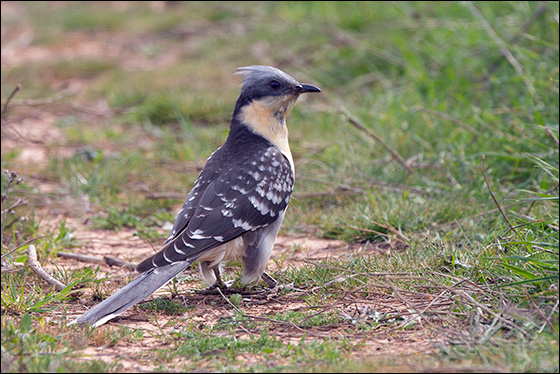Great Spotted Cuckoo (Clamator glandarius)
Italy and the eastern Balkans. A migrant like the Common Cuckoo, the adults depart Europe in July whilst the juveniles hang contentedly around in the breeding areas and finally drift away, somewhat grudgingly, by November. Since the adults reappear as early as February, the species is only missing for a few weeks each year.
Although it is a brood parasite like the Common Cuckoo, the Great Spotted Cuckoo has very different hosts: not small insectivorous birds, but Magpies and Carrion Crows. Not surprisingly many aspects of its behaviour also differ markedly from the Common Cuckoo. For one thing the approach to a nest is not performed by the female alone, but by a pair. The case for having two raiders is readily apparent; the male appears in full view and distracts the hosts’ attention, while the female advances through the thick branches unnoticed to lay her egg. She is taking a big risk, because if intercepted nearby or even inside the structure, she could be attacked and badly injured. Without the male present it is doubtful whether many raids could be successful.
When laying in a Magpie’s nest the female Great Spotted Cuckoo is usually in and out within 10 seconds; for Carrion Crows, which have open, not domed nests, it can be as quick as 3 seconds – again, to avoid attack. In contrast to the Common Cuckoo the female does not remove and eat a host egg, but she might deliberately chip one or two of the Magpie’s clutch to make sure they don’t hatch, or ensure that she lays her harder-shelled egg right on top of them, to crack them this way instead. Incidentally, Great Spotted Cuckoos regularly lay more than one of their own eggs in the same nest.
Naturally, the eggs hatch before those of the host: the Magpie’s incubation period is 18-22 days, the Cuckoo’s only 12-14 days. However, in contrast to the Common Cuckoo, the youngster does not evict any of its fellow nest-fellows, neither eggs nor young; this is because Magpies calibrate the amount of food they bring in with the size of clutch, and a Cuckoo might not receive enough food on its own. Instead, the youngster, having at least four days start on its host’s young and a faster growth rate to boot, can normally out-compete them for the parents’ offerings, causing the host chicks eventually to starve. The begging routine of the Great Spotted Cuckoo specially mimics the begging levels of an extremely hungry Magpie chick, duping the parents into thinking that its needs are always paramount, even when it is in fact satiated.

